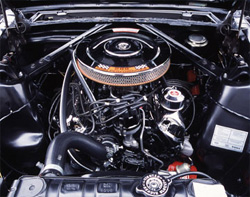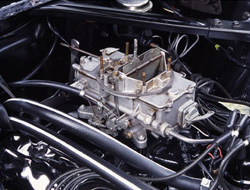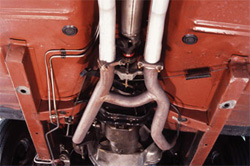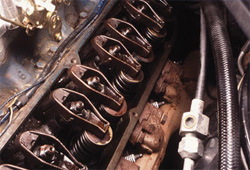Featured Powerplant: 221-302 Windsor Engine Magic
One of the best engines in the world.
No doubt about it, the Windsor series of Ford engines are some fo the finest in the world. With their introduction in the 1962 model year at a modest 221 c.i.d. in the then new intermediate Fairlane, all the way up to the ground-pounding Boss 302, these were some of the best engines built by any motor company in the world. They've been proven on the street as an everyday commuter engine, and they've been proven winners on racetracks throughout the world. These ubiquitous little engines have won on the drag strip, in road races, endurance events, rallies, and even triumphed in economy runs. Their simple, yet durable architecture allowed them to lead a plebeian life in everything from a Falcon to the Galaxie, yet they were known as the engine to beat in the Mustang and the Cobra. And talk about interchange, almost all the basic parts from the 221, 260, 289, and 302 engines would interchange, even though in most instances you wouldn't want to.

Let's talk about some historical background to this world-class engine. Ford realized that the heavy and outdated Y-block series of engines, first developed in the early Fifties, needed to be replaced going into the decade of the Sixties. The new engine needed to compete with (and please forgive me for saying this word in this magazine), the Chevrolet small-block V8. And because the new intermediate and pony cars were going to be of uni-body construction, they needed to have a lightweight engine package to fit in the smaller engine compartments. In the fall of 1961, when Ford introduced the new Fairlane intermediate coupe, they also introduced the 221 c.i.d. Windsor V8, the same size as the original Ford flathead V8 of 1932. And lightweight it was, at only 450 pounds with the accessories bolted on. But alas, the 221 was a marginal performer at best, so as a stop-gap measure, Ford upped the size to 260 cubes in mid-1962, and the 221 was phased out in 1963, never to be seen again. An interesting fact is that both the 221 and the 260 were only available from the factory in production vehicles with a 2-barrel Autolite carburetor. The 260 was used in everything from the Falcon all the way up to the heavyweight Galaxie, but was discontinued in the 1965 model year.

Though the 260 was much better than the 221 in terms of power, it still didn't have the performance that Ford felt was indicative of its Total Performance program for 1963, so they trotted out the 289 mid-year, including the world-class 289/271 hp K-code engine. With the 289, Ford had hit a home run straight out of the ballpark. It had enough power in its mundane, everyday 2-barrel version to offer the customer that wanted a basic V8 in his or her Galaxie or Mustang, just the right amount of performance. Then there were the hydraulic-cammed, 4-barrel 289s that offered the majority of customers the perfect blend of economy and performance. And as a bit of trivia, this 4-barrel 289 was offered in two different power ratings; from 1963 through 1964 it was rated at 210 hp, but from then on it was rated at 225 hp. But for those that wanted the most powerful of the new 289 Windsor engines, there was the 6000 RPM, 271 horsepower K-code engine with its screw-in rocker studs, and adjustable valvetrain. This incaranation was introduced with all the other 289 derivations in mid-1963. At first this engine was only offered in the Fairlane sports coupe, but was soon released for use in the Falcon Sprint and Mustang in '64, then the Galaxie in 1965.

With vehicles getting heavier, emissions playing a bigger role, and performance becoming increasingly important in sales and marketing, Ford developed the 302 Windsor engine and released it into 1968 model production sometime around November/December of 1967. For the beginning of the 1968 model year, the 289 was used in 2-barrel form. But after December of '67, it was phased out of production. And talk about longevity, the 302 in its basic form was used from 1963 all the way through 1996. Talk about an engine for the ages, almost three decades worth of use makes the 302 one of the most prolific and durable engines of all time, which included use in everything from passenger cars to pickups to boats.

And now a word or two about the top dog small-displacement Windsor engine, the 1969-70 Boss 302. Expressly developed for Trans Am racing, most know the Boss was not a full-on Windsor as it used Cleveland-based heads, but the bottom-end was strictly based on the Windsor architecture. It was the ultimate in strength and durability for its time, featuring a forged steel crank, special forged pistons and connecting rods and a four-bolt main cap bottom end with a cap-mounted windage tray. With the deep-breathing Cleveland heads, aluminum high-rise manifold with Holley 780 cfm vacuum secondary carb, and fully adjustable valvetrain with mechanical cam, this engine made all its power above 3500 RPM and would rev into the stratosphere. To try to get some more street tractability in 1970, the size of the intake valves in the heads was reduced from 2.25" diameter to 2.19", but not the power output. To be realistic, it didn't make any difference. It still wouldn't run well below 3500 RPM, but above that it was like a banshee had been let loose. The factory cam was good for 7000 RPM and was a great performer if you disconnected the factory rev-limiter. At a very under-rated 290 hp, this was the most powerful of all the small-displacement Windsor engines, and yet it only had a two-year production run. Rumor has it that the Boss 302 was going to be used in the 1971 Mustang, but due to emissions and costs concerns on this very low production engine, it was replaced by the Boss 351 Cleveland engine. But what a way to go out of production on your last year, 1970, winning the driver's and manufacturer's championship in Trans Am road racing, just what the Boss was built for.
Complete article now available in issue #2 of Legendary Ford Magazine
To read this article in its entirety, visit Legendary Ford Magazine online and subscribe today!
Note: SuperMotors has a business affiliation with Legendary Ford Magazine, which provides Ford, Lincoln, and Mercury articles and content to SuperMotors.
Back to the Issue #2 index.